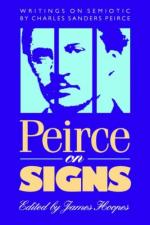|
This section contains 2,559 words (approx. 9 pages at 300 words per page) |

|
The logical work of Charles Sanders Peirce (1839–1914) was an unusual blend of the traditional and the modern. His early paper "Memoranda concerning the Aristotelian Syllogism," read and distributed in 1866, adapted to the second and third syllogistic figures Kant's description of first-figure reasoning as the subsumption of a case under a rule, and in later papers he exhibited analogy and induction as probabilistic weakenings of the second and third figures thus conceived. In 1867, independently of Jevons, Peirce improved Boole's logical algebra by identifying logical addition with the inclusive rather than the exclusive sense of "either-or." In 1870, inspired by De Morgan's pioneer work on the logic of relations, he extended Boole's method of algebraic analogy to this discipline, noticed that there are three-termed as well as two-termed relations, and introduced the sign "≺" for class inclusion, considered an analogue of the arithmetical "≤."
In 1880, Peirce began to use the symbol "≺" indifferently for...
|
This section contains 2,559 words (approx. 9 pages at 300 words per page) |

|


